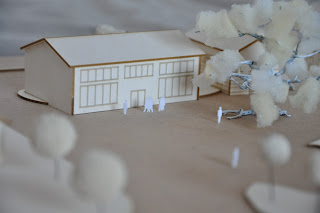Hello out there!
You can find many tutorials about silicone molds in the Internet (I suggest the HirstArts homepage), but today I want to show you something which was new to me.
My friend Mati aka Badsmile (you can find him over at
http://massivevoodoo.blogspot.com/ )
told me about this very useful stuff, called SI6GB two component silicone.
The greatest advantage is simple, you don't have to mix a big amount of silicone with a tiny amount of curing agent (which can be very hard to do and destroy your whole work if done wrong).
Instead you take 50 % of component A, 50 % of component B mix them together and you are ready to mold.
The second advantage is the time you need. While the old silicone I used (Silcotin HB) took hours to dry out (a whole day until you could actually cast something) the new one needs 60 minutes do get hard enough to get your master out and just 3 hours until you can start casting.
So it is easier, faster and I couldn't notice big differences in price.
You can buy the silicone at ebay in different amounts.
Notice that you should not mold and cast whole minis from manufacturers!
It is illegal and you hurt the company (especially little miniature manufacturers need every cent they can).
This is for self-created stuff and little bitz you might need.
And now how to mold:
The things we need:
- some lego to build our mold
- SI6GB two component silicone
- a few cups (take the ones you just use one time, for you will never be able to clean your favorite mug)
- an old brush
- some sticks to stir
- your master
- mold release agent
Build the form to pour the silicone in, best for that is lego, because you can build thousand of different forms again and again. Silicone is expensive, you shouldn't waste some with to large forms! Be sure to glue the stones to your ground plate (which should be water resistant). I use double-sided tape for that.
For this tutorial, I will mold a little cogwheel, because I had no other masters around.
Take dry rice (or anything else you can through in, should be dry and non-sticky) and fill your form (with master in it).
Now take the rice and weigh the amount. This will give us a rough amount of silicone we will need.
I usually take 5 to 10 gram more to be on the safe side.
Now take the release agent and your first brush (be sure to clean it very careful or better use a new one later) and brush the whole form (for better release) and the master. It is very important that you don't take to big amounts, we don't want detail to get lost. Everything should be smooth and there shouldn't be visible brush strokes or hairs.
By the way this are the two components:
Start filling your cup with component A (or B if you prefer, no difference at all) and weigh carefully!
It should be 50:50 and differences can slow the drying process or even make it impossible!
Then fill the next component, be sure to have the same amount. Then you have one to two minutes to mix them up, you should stir slowly and careful, we don't want to much bubbles (I never get it without, so don't worry a few are ok). Be sure to stir at the edges too.
The result should look mint green.
The components before mixing and the ready silicone.:
Then take your second brush and a small amount of silicone. Brush it to your master and be sure to push all the bubbles out and silicone into every small crack and hole. This ensures that every detail will be molded.
If you don't notice your photoslaves taking shots of you, you are just focused enough :)
Pour the silicone in. It works best if applied beside the master, so we don't push our first brushed layer away. After filling, knock against the table to shake out air bubbles. This can be done for five minutes, was enough for this example. Let it dry (and don't....DON'T be impatient) for 60 minutes.
Be sure to put all your projects far away from silicone and molding.
If you want to use your tools more than one time clean them instantly.
After 60 minutes you can remove the legos and your master. Now just wait another two hours and start casting. This is our first mold with the new material and it didn't came out perfect but there where some negative conditions (cold around, very impatient as always, my mind was far away at some troubles that haunt me this days).
I sure will show you our new forms, when they are done.
Only one thing left to say, this stuff is awesome, molding becomes way easier with it.
Happy molding and greets!




















































